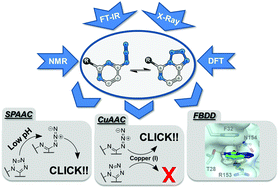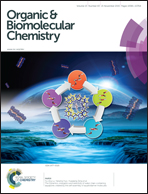Steering the azido–tetrazole equilibrium of 4-azidopyrimidines via substituent variation – implications for drug design and azide–alkyne cycloadditions†
Abstract
This paper focuses on an interesting constitutional isomerism called azido–tetrazole equilibrium which is observed in azido-substituted N-heterocycles. We present a systematic investigation of substituent effects on the isomer ratio within a 2-substituted 4-azidopyrimidine model scaffold. NMR- and IR-spectroscopy as well as X-ray crystallography were employed for thorough analysis and characterization of synthesized derivatives. On the basis of this data, we demonstrate the possibility to steer this valence tautomerism towards the isomer of choice by means of substituent variation. We show that the tetrazole form can act as an efficient disguise for the corresponding azido group masking its well known reactivity in azide–alkyne cycloadditions (ACCs). In copper(I)-catalyzed AAC reactions, substituent-stabilized tetrazoles displayed a highly decreased or even abolished reactivity whereas azides and compounds in the equilibrium were directly converted. By use of an acid sensitive derivative, we provide, to our knowledge, the first experimental basis for a possible exploitation of this dynamic isomerism as a pH-dependent azide-protecting motif for selective SPAAC conjugations in aqueous media. Finally, we demonstrate the applicability and efficiency of stabilized tetrazolo[1,5-c]pyrimidines for Fragment-Based Drug Design (FBDD) in the field of quorum sensing inhibitors.


 Please wait while we load your content...
Please wait while we load your content...